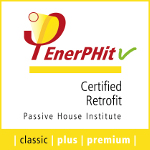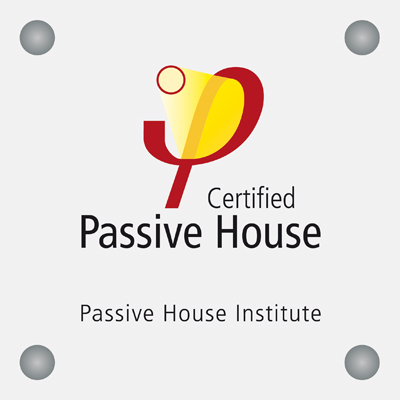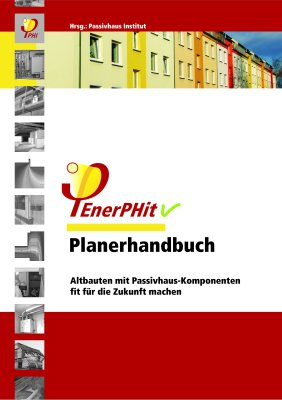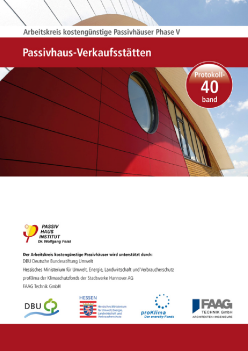Research Group for Cost-effective Passive Houses - Phase I: 1996 till 1998
Carried out on behalf of:
- the Hessian Ministry for Environment, Energy, Youth, Family and Health
- Ministry for Construction and Housing of the State of Northrhine-Westfalia,
- Stadtwerke Hannover AG,
- PreussenElektra AG.
- VEBA IMMOBILIEN AG.
Monitoring of the construction of second-generation Passive Houses
Experiences with the first inhabited Passive Houses were so impressive that it was possible to introduce this building standard with a separate heating system in the following years. The results from projects relating to cost-saving construction were also incorporated so that second-generation Passive Houses would become cost-effective residential buildings without a heating system.
The Research Group was entrusted with the task of monitoring and providing technical assistance for planning and construction of Passive Houses. It was intended to constitute a link between the project teams for specific building construction projects, technical component development, and scientific monitoring by the Passive House Institute (PHI).
The first phase of the Research Group ended, but was continued in another form.
Passive Houses are buildings with an excellent standard of thermal protection which do not require a heating system.
Experience with energy-efficient construction has shown that there will be two inherently consistent, coherent concepts for energy-efficient buildings in the future:
The low-energy house,
in which it is possible to achieve a specific heating demand between 30 and 70 kWh/(m²a) due to the good level of thermal protection, insulating glazing and an economical exhaust air ventilation system. However, such a house still needs a conventional hot water-based heating system for several reasons.
The Passive House (PH),
in which a specific heating demand of <15 kWh/(m²a) is possible due to even better thermal protection, low-e triple glazing, and a supply air/extract air ventilation system with highly efficient heat recovery. Dispensing with a conventional heating system is possible under these conditions. All of the measures mentioned are established technology that is also used in low-energy houses, but they incur additional investment costs. A more advanced concept than the low-energy house would not be economically feasible if it has to be amortised solely through savings in running costs; however, the Passive House is a simplified concept in which the investment costs for a heating system are substituted by those for the ventilation technology.
Existing house |
Low-energy house |
Passive House |
Zero-energy house |
|
Energy |
280 - 180 kWh/(m²a) |
70 - 30 kWh/(m²a) |
< 15 kWh/(m²a) |
0 kWh/(m²a) |
Heating |
yes |
yes |
no |
? |
Ventilation |
no |
yes |
yes |
yes |
Thermal |
mittel |
gut |
very good |
? |
Construction |
investment costs: high |
investment costs: average |
investment costs: average |
investment cost: very high |
Running |
high |
low |
minimal |
auxiliary energy |
Consistent progress from a poorly insulated existing building to a low energy house and beyond that, to a Passive House - investment costs are saved by dispensing with the heating system. Thermal comfort keeps increasing, energy consumption and environmental impact decrease; expenditure for the zero-energy house increases again due to the additive systems.
Research Group for Cost-effective Passive Houses - Phase I
The Research Group was coordinated by the Passive House Institute and sponsored by the following:
- the Hessian Ministry for Environment, Energy, Youth, Family and Health
- Ministry for Construction and Housing of the State of Northrhine-Westfalia,
- Stadtwerke Hannover AG,
- PreussenElektra AG.
- VEBA IMMOBILIEN AG.
Members of the Research Group for Cost-effective Passive Houses were:
- Representatives of the sponsors mentioned previously,
- Staff of the Passive House Institute and the Institute for Housing and Environment (IWU),
- Architects, property developers and building services engineers of the second-generation Passive Houses that were to be realised during the period from 1996 to 1998. The decision to include a team of Passive House designers in the Research Group was taken unanimously by the sponsors. Participation was free for the architects; in return, the team provided draft designs and calculations for each construction project free of charge to the Research Group for its scientific publications.
- Developers of special components for thermal protection or building services for each individual case.
- Engineering consultants for energy, building services and ecological concepts ebök/Tübingen as experts for building services.
- Invited international cooperation partners who were working on the implementation of Passive House projects outside of Germany; the decision for their participation was also taken unanimously by the sponsors.
The Research Group members came together for a total of 12 closed sessions. The latest information was exchanged during the lectures and discussions relating to the respective focal points such as thermal insulation, ventilation or ecology. Protocol Volumes were prepared for each session which can be ordered from the Passive House Information Group. See the information regarding the Passive House Information Group on the page about Phase II of the Research Group.
Order Research Group Volume online (in German)
| Next Courses |
PHPP Expert
Passive House Designer / Consultant
Construction Verifier
Site Supervisor
![]() read more
read more
e-learning
| Events |
iPHA Webinar "Project Spotlight: The CLT 8-floor ANMF hotel in Melbourne, Australia with heritage overlay." | November 12, 2025
![]() read more
read more
![]() Passive House Open Days |
Passive House Open Days |
7 - 9 November 2025
![]() read more
read more
![]() 24 - 25 April 2026, Essen, Germany
24 - 25 April 2026, Essen, Germany
![]() read more
read more
| Component Database |
 Passive House
Passive House
Component Database
read more
| Projects |
| New developments |
![]() designPH
designPH
read more
![]() NEW: PHPP 10 (2021)
NEW: PHPP 10 (2021)
read more
 Seals for Certified Passive House Components
Seals for Certified Passive House Components
read more
 Passive House Classes,
Passive House Classes,
Classic, Plus, Premium
read more
 EnerPHit -
EnerPHit -
PHI certification for retrofits
read more
 Wall plaque
Wall plaque
for certified Passive Houses
read more
| Press releases |
| Research & Literature |
![]() Passive Houses for different climate zones
Passive Houses for different climate zones
more
 Retrofits with Passive House components -
Retrofits with Passive House components -
EnerPHit Planner Handbook
(in German)
 Passive House Retail Stores now out
Passive House Retail Stores now out
Overview of contents
(in German)


